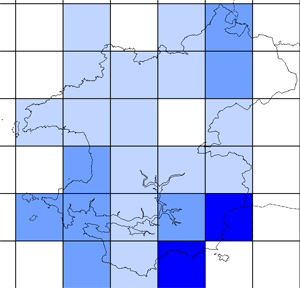Breeding resident and passage migrant
A common resident/according to Mathew (1894) and Lockley et ai. (1949), the Greenfinch currently breeds across Pembrokeshire (see map) being found especially around gardens and where there are scattered trees. At an estimated 15 to 20 pairs per tetrad the county total would be 4,000-5,000 pairs.
Small numbers are recorded passing through coastal areas between 7 March and 12 June, and again from 27 September to 6 December. They stop off at the islands, including the remoter isles such as the Smalls, and one ringed at Skokholm was later recovered in County Wexford, Ireland.
They flock in winter at good food sources, such as seeded turnips and flax, are increasingly frequent at bird-tables and form communal roosts in dense shrubbery, for instance in blackthorn at the Gann.

Fieldwork 1984-88 (based on 478 tetrads)
Red = breeding confirmed = 70
Orange = breeding probable = 134
Yellow = breeding possible = 57
Total tetrads in which registered = 261 (54.6%)
Donovan J.W. & Rees G.H (1994), Birds of Pembrokeshire
 Friday, July 26, 2013 at 9:28AM
Friday, July 26, 2013 at 9:28AM  1949 BoP in
1949 BoP in  Greenfinch
Greenfinch 





